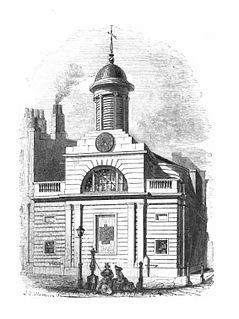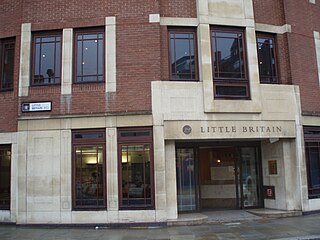
The Worshipful Company of Butchers is one of the Livery Companies of the City of London, England. Records indicate that an organisation of butchers existed as early as 975; the Butchers' Guild, the direct predecessor of the present Company, was granted the right to regulate the trade in 1331. The Butchers' Guild was incorporated by Royal Charter centuries later, in 1605. The Butchers' still, unlike other Livery Companies, continues to exist as a trade association for members of the industry, instead of evolving into an institution primarily dedicated to charity. However, the Company does contribute, like all Livery Companies, to various charities.

Threadneedle Street is a street in the City of London, England between Bishopsgate at its northeast end and Bank junction in the southwest. It is one of nine streets that converge at Bank. It lies in the ward of Cornhill.

Eastcheap is a street in central London that is a western continuation of Great Tower Street towards Monument junction. Its name derives from cheap, the Old English word for market, with the prefix 'East' distinguishing it from Westcheap, another former market street that today is called Cheapside.

The Golden Boy of Pye Corner is a small late-17th-century monument located on the corner of Giltspur Street and Cock Lane in Smithfield, central London. It marks the spot where the 1666 Great Fire of London was stopped, whereas the Monument indicates the place where it started. The statue of a naked boy is made of wood and is covered with gold; the figure was formerly winged. The late 19th-century building that incorporates it is a Grade II listed building but listed only for the figure.
The EC postcode area, also known as the London EC postal area, is a group of postcode districts in central London, England. It includes almost all of the City of London and parts of the London Boroughs of Islington, Camden, Hackney, Tower Hamlets and Westminster. The area covered is of very high density development. Deliveries for the EC postcode area are made from Mount Pleasant Mail Centre.

St. Bartholomew-by-the-Exchange was a church and parish in the City of London located on Bartholomew Lane, off Threadneedle Street. Recorded since the 13th century, the church was destroyed in the Great Fire of London in 1666, then rebuilt by Sir Christopher Wren. The rebuilt church was demolished in 1840.

St Martin Outwich was a parish church in the City of London, on the corner of Threadneedle Street and Bishopsgate. Of medieval origin, it was rebuilt at the end of the 18th century and demolished in 1874.

Lothbury is a short street in the City of London. It runs east–west with traffic flow in both directions, from Gresham Street's junction with Moorgate to the west, and Bartholomew Lane's junction with Throgmorton Street to the east.

Gresham Street in the City of London is named after the English merchant and financier Thomas Gresham.

St Benet Fink was a church and parish in the City of London located on what is now Threadneedle Street. Recorded since the 13th century, the church was destroyed in the Great Fire of London of 1666, then rebuilt to the designs of Sir Christopher Wren. The Wren church was demolished between 1841 and 1846.

Little Britain is a street in the City of London running from St. Martin's Le Grand in the east to West Smithfield in the west. It is situated in the Aldersgate and Farringdon Within wards. Postman's Park is also bounded by Little Britain.

St Christopher le Stocks was a parish church on the north side of Threadneedle Street in the Broad Street Ward of the City of London. Of Medieval origin, it was rebuilt following the Great Fire of London in 1666, but demolished in 1781 to make way for an extension of the neighbouring Bank of England.

Queen Victoria Street, named after the British monarch who reigned from 1837 to 1901, is a street in London which runs east by north from its junction with New Bridge Street and Victoria Embankment in the Castle Baynard ward of the City of London, along a section that divides the wards of Queenhithe and Bread Street, then lastly through the middle of Cordwainer ward, until it reaches Mansion House Street at Bank junction. Beyond Bank junction, the street continues north-east as Threadneedle Street which joins Bishopsgate. Other streets linked to Queen Victoria Street include Puddle Dock, Cannon Street, Walbrook and Poultry.

St Botolph's, Billingsgate was a Church of England parish church in London. Of medieval origin, it was located in the Billingsgate ward of the City of London and destroyed by the Great Fire of London in 1666.

St Martin Pomeroy was a parish church in the Cheap ward of the City of London. It was also known as St Martin Ironmonger Lane.

St Nicholas Shambles was a medieval church in the City of London, which stood on the corner of Butcher Hall Lane and Newgate Street. It took its name from the Shambles, the butchers area in the west of Newgate Street. The church is first mentioned as St. Nicholas de Westrnacekaria. In 1253 Walter de Cantilupe, Bishop of Worcester granted indulgences to its parishioners.

The Lanes are a collection of narrow lanes in Brighton, in the city of Brighton and Hove famous for their small shops and narrow alleyways.

Lombard Street is a street notable for its connections with the City of London's merchant, banking and insurance industries, stretching back to medieval times.

Ye Olde Cock Tavern is a Grade II listed public house at 22 Fleet Street, London EC4. It is part of the Taylor Walker Pubs group.

Blossom's Inn was a tavern which stood in Lawrence Lane in the City of London from the 14th century until 1855. It became a substantial coaching inn and was used as a staging post by carriers of goods. In the 19th century, the lease was bought and it became the parcel depot of the Great Eastern Railway. Its name was used for a major property development at the end of the 20th century and the site is now part of the large complex of 30 Gresham Street.




















